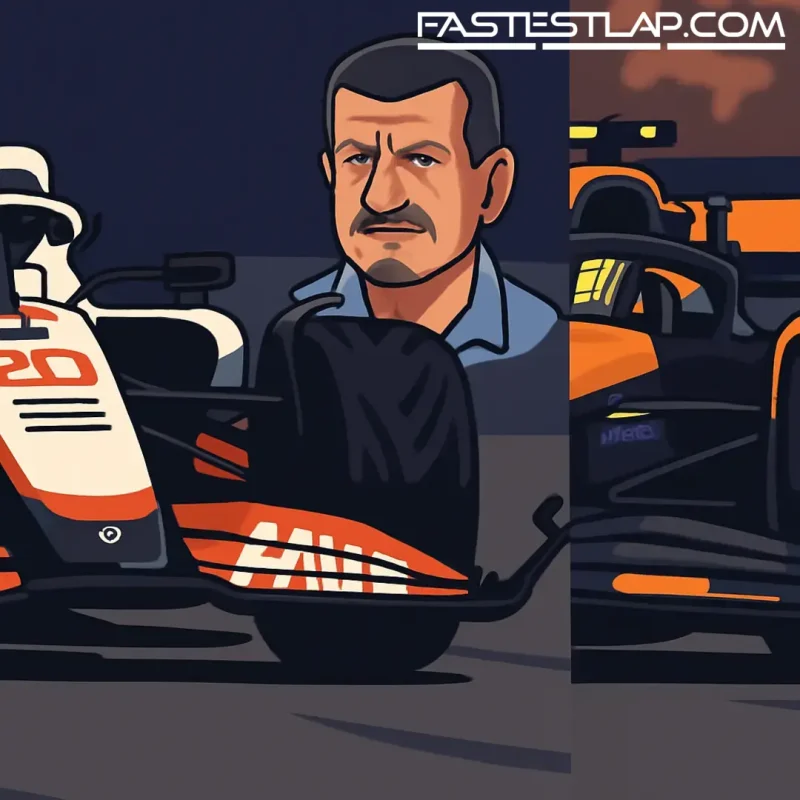Guenther Steiner says Lando Norris owes him a thank-you note after Singapore.
The former Haas team boss resurfaced on the Red Flags Podcast this week with a familiar grievance and a fresh punchline, arguing that the more measured approach to damaged-car calls we saw at Marina Bay is partly the result of Haas banging the drum back in 2022 — when Kevin Magnussen’s races were repeatedly kneecapped by the black-and-orange “meatball” flag.
Norris, who made light contact with Max Verstappen at the start in Singapore and picked up a nicked front-wing flap, wasn’t summoned to the pits and duly finished third. He later admitted he barely noticed the damage. In 2022, that would’ve been an automatic trip to the box.
“At the time, there was a race director who just wasn’t up to it,” Steiner said. “He was obsessed with parts on cars. We explained the wing construction, that the part wouldn’t fall off. He didn’t care: ‘It’s dangerous, you need to come in.’ Lando should thank me — he would’ve been made to change his front wing.”
Haas lived that reality. Magnussen was meatballed three times in 2022, including in Singapore for a similar front-wing issue. The enforced stop wrecked his day and he came home 12th. That run of calls, and a later flashpoint when Fernando Alonso’s mirror detached mid-race without triggering the same response, triggered a rethink inside the FIA.
Steiner says the rulebook moved to a saner place after that. Rather than yanking cars in at the first sight of a scuffed flap, race control now leans on team responsibility and engineering reality — not least because modern front wings use tethers and high-strength fibers (think Zylon) to keep bits attached unless they’re deliberately cut away.
“The best thing was salt in the wound when Fernando was alright to lose the rear-view mirror — which is a lot more dangerous,” Steiner added. “Then Mohammed Ben Sulayem got involved and changed the rule so it’s actually okay to have pieces hanging loose. The team is responsible. All the teams know how the wing is constructed. The parts will not fall off. We had the same, but the rules changed.”
Steiner didn’t name names, but the 2022 race direction setup — split early on, then consolidated — came under heavy scrutiny before changing again. The role has since moved on, and the current regime has clearly taken a more pragmatic view of surface-level damage when it isn’t shedding carbon and isn’t a hazard.
This isn’t about laissez-faire officiating; it’s about context. A flapping endplate at 300km/h that’s about to liberate itself? Pit, now. A scuffed flap that isn’t moving and has no performance or safety consequence? Let the race breathe. Singapore showed that nuance is back in fashion.
It also highlights something teams have argued for years: they know what’s likely to stay on the car and what isn’t. Between sensor data, onboard cameras and the driver’s feedback, the pit wall has enough to make an informed call — and race control can always overrule if it sees risk. That’s a healthier balance than the knee-jerk approach that ruined more than a few midfield Sundays in 2022.
Steiner being Steiner, the delivery was spiky. “This race director, who had these ideas, was never seen again in Formula 1,” he said. “Rightly so… ‘I’m the race director, I do what I find is right.’ Lando should thank me!”
Whether Norris sends flowers or not, the broader point stands. In 2025, with driver line-ups largely settled and the sport’s leadership trying to steady the temperature around officiating, the meatball is no longer the star of the show. And as McLaren’s lead man proved under the lights, sometimes a little scar on the nose doesn’t need to become the story.
Context for the newer fans: Norris leads McLaren’s charge in 2025, while Magnussen’s Haas bruisers of old are now a memory — and a cautionary tale — in this ongoing debate about consistency and common sense. The wheel turns; the rules evolve. For once, this is progress that most of the paddock can get behind.




